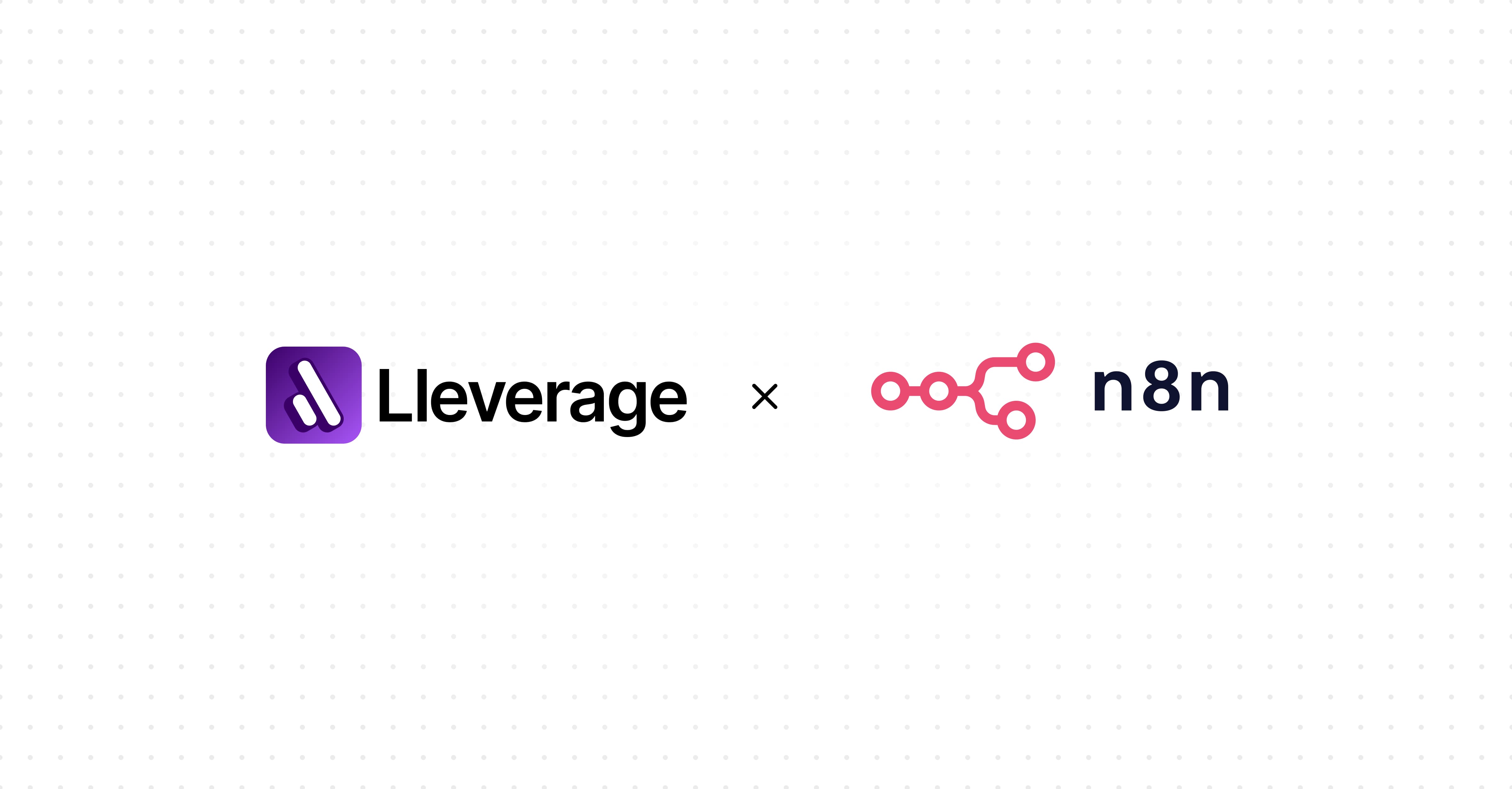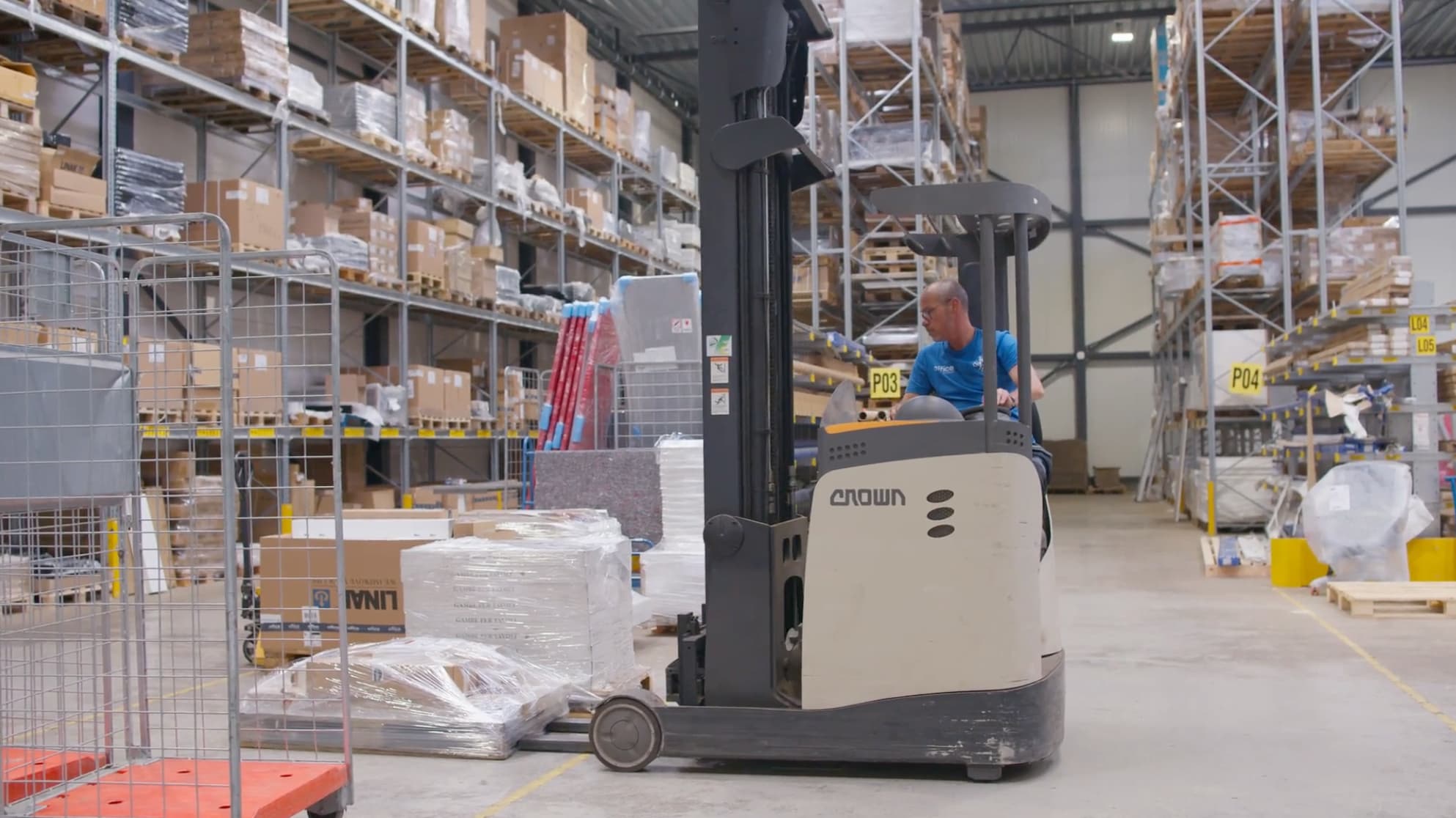15 Best n8n Alternatives for Modern Workflow Automation in 2025
Most businesses struggle with n8n's technical complexity and maintenance requirements. This guide explores 15 superior alternatives, from AI-native platforms like Lleverage that let you create automations in plain English, to user-friendly options like Zapier and Make. Includes pricing comparisons, real-world ROI examples, and implementation guidance to help you choose the right automation solution for your business needs.

Would you believe me if I told you that n8n isn't the only game in town when it comes to workflow automation? In fact, while n8n has built a solid reputation as the go-to open-source automation platform, there's a whole ecosystem of alternatives that might be better suited to your specific needs.
After analyzing over 100 automation platforms and speaking with hundreds of business leaders about their workflow challenges, I've discovered something fascinating: while n8n is powerful, it's not always the best fit for every business. Whether you're dealing with complex document processing, need natural language automation, or simply want something more user-friendly, there's likely a better alternative for your specific use case.
In this article, I'll break down the 15 best n8n alternatives in 2025, from AI-native platforms that understand context to no-code tools that make automation accessible to everyone. You'll discover which tools are worth your time and which ones to avoid, based on real-world performance and user feedback.
Why Look for n8n Alternatives?
Don't get me wrong - n8n is a solid platform. It's open-source, self-hostable, and offers impressive customization options. But like any tool, it has its limitations.
The Reality Check
Despite n8n's popularity (over 116,000 GitHub stars), many businesses struggle with:
Technical Complexity: n8n requires significant technical expertise to set up and maintain. If you can't program, using n8n effectively becomes nearly impossible.
Steep Learning Curve: The platform assumes you understand APIs, webhooks, and coding concepts that many business users find intimidating.
Limited AI Capabilities: While n8n can integrate with AI services, it lacks native AI understanding. You can't simply describe what you want in plain English and have it work.
Self-Hosting Burden: The self-hosted option requires server management, security updates, and technical maintenance that many teams aren't equipped to handle.
Maintenance Overhead: Workflows break when APIs change, requiring constant updates and monitoring by technical staff.
What Modern Businesses Actually Need
After speaking with over 150 tech leaders across Europe, a clear pattern emerged: businesses want automation that's:
- Accessible: No coding required for basic automations
- Intelligent: Can handle unstructured data and make decisions
- Scalable: Works for both simple and complex processes
- Reliable: Doesn't break when external services change
- Fast to implement: Days, not months to get results
This is why alternative platforms are gaining traction. They're addressing the gaps that n8n leaves unfilled.
The Modern Automation Landscape
The automation world has evolved dramatically. We're seeing three distinct generations of workflow tools:
First Generation: Rule-Based Automation (2010s)
Traditional tools like early Zapier focused on simple if-this-then-that logic. They worked well for basic app connections but struggled with complexity.
Second Generation: Visual Workflow Builders (2020s)
Platforms like n8n, Make, and modern Zapier added visual editors and more sophisticated logic. They made automation more accessible but still required technical thinking.
Third Generation: AI-Native Automation (2025+)
New platforms like Lleverage and Lindy use artificial intelligence as their foundation. Instead of programming workflows, you describe what you want in natural language.
The key insight? We're moving from explicit programming to intelligent automation that understands context and adapts to change.
Top 15 n8n Alternatives
1. Lleverage - The AI-Native Pioneer
Best for: Complex document processing, intelligent decision-making, and natural language automation
Lleverage represents a fundamentally different approach to automation. Built from the ground up as an AI-native platform, it enables companies to automate complex business processes using natural language instead of code.
Why it's different: While n8n requires technical configuration, Lleverage uses "Vibe Automation" - you simply describe what you want to automate in plain English, and the platform builds it for you in minutes.
Key Features:
- Natural language automation creation
- Process complex documents automatically with data extraction, content analysis, and summary generation
- Built-in vector databases and RAG pipelines
- Over 2,000 integrations
- Multiple deployment options (API, chat, forms, embedded)
Real Results: Companies using Lleverage have eliminated 15-person manual data extraction teams, saving over €300,000 annually, and reduced quote creation time by 90%. See detailed case studies in our platform comparison.
Pricing: Forever free account with no functionality limitations; paid plans for scale
Who it's for: Businesses dealing with unstructured data, complex processes, or teams that want to automate without technical expertise
Read our detailed comparison of n8n vs Lleverage vs Make vs Zapier
2. Zapier - The Simplicity Champion
Best for: Quick app connections, marketing automation, and non-technical users
Zapier remains the gold standard for simple automation. With over 7,000 app integrations, it's the most accessible option for business users.
Key Features:
- Massive integration ecosystem
- Intuitive "if this, then that" logic
- Templates for common workflows
- AI-powered workflow suggestions
Limitations:
- Task-based pricing becomes expensive quickly
- Limited data manipulation compared to technical platforms
- Struggles with complex, multi-step processes
Pricing: Free tier (100 tasks/month); Professional plan from $29.99/month, Team plan from $103.50/month, Enterprise plan (custom pricing)
3. Make (formerly Integromat) - The Visual Powerhouse
Best for: Complex visual workflows, data transformation, and teams that like seeing connections
Make excels at creating sophisticated automations through its visual interface.
Key Features:
- Powerful visual workflow builder
- Advanced data manipulation
- Flexible scheduling options
- Strong error handling
Limitations:
- Can become overwhelming for complex scenarios
- Learning curve steeper than Zapier
- Limited AI capabilities beyond basic integrations
Pricing: Free tier (1,000 operations/month); Core plan $10.59/month, Pro plan $18.82/month, Teams plan $34.12/month, Enterprise plan (custom pricing)
4. Lindy - The AI Agent Builder
Best for: Creating task-specific AI agents without coding
Lindy focuses on building AI agents (called "Lindies") that can handle specific business functions.
Key Features:
- No-code AI agent creation
- Pre-built agent templates
- Natural language configuration
- 50+ integrations
Limitations:
- Smaller integration library compared to established platforms
- Newer platform with evolving features
Pricing: Free tier (400 task credits/month); paid plans from $49/month
5. Microsoft Power Automate - The Enterprise Choice
Best for: Organizations already using Microsoft 365, enterprise compliance needs
Power Automate integrates seamlessly with Microsoft's ecosystem and offers enterprise-grade features.
Key Features:
- Deep Microsoft 365 integration
- AI Builder for custom models
- Desktop automation (RPA)
- Enterprise security and compliance
Limitations:
- Most powerful within Microsoft ecosystem
- Can be complex for non-technical users
- Limited compared to specialized platforms
Pricing: Premium plan $15/month per user, Process plan $150/month, Hosted Process plan $215/month
6. Node-RED - The IoT Specialist
Best for: IoT projects, hardware integration, and developers comfortable with self-hosting
Node-RED is perfect for Internet of Things applications and hardware-software integration.
Key Features:
- Flow-based programming
- Extensive community nodes
- IoT device integration
- Custom JavaScript functions
Limitations:
- Steep learning curve
- Requires technical expertise
- Limited native business app integrations
Pricing: Free (open-source, self-hosted); managed hosting available through FlowFuse from $9/month
7. Activepieces - The Open-Source Alternative
Best for: Teams wanting n8n-like functionality with better user experience
Activepieces offers open-source automation with a more user-friendly interface than n8n.
Key Features:
- Open-source and self-hostable
- No-code interface
- Growing integration library
- Community-driven development
Limitations:
- Smaller ecosystem compared to commercial platforms
- Limited advanced features
- Requires self-hosting expertise
Pricing: Free (open-source, self-hosted); cloud hosting available from $15/month
8. Huginn - The Developer's Choice
Best for: Developers who want complete control and customization
Huginn is built for developers who need maximum flexibility and aren't afraid of code.
Key Features:
- Complete customization
- Agent-based architecture
- Self-hosted
- GitHub integration
Limitations:
- Requires significant technical expertise
- Limited out-of-the-box integrations
- Not suitable for non-technical users
Pricing: Free (open-source)
9. Windmill - The "Code-First" Platform
Best for: Technical teams who want to treat automation as code
Windmill combines the benefits of code-based automation with visual workflows.
Key Features:
- Code-first approach
- Self-hostable
- Built-in observability
- Developer-friendly
Limitations:
- Requires programming knowledge
- Limited non-technical user features
- Newer platform with growing ecosystem
Pricing: Free tier; paid plans from $20/month
10. Latenode - The Innovation Bridge
Best for: Teams wanting AI features with visual workflow building
Latenode bridges traditional automation with AI-powered capabilities.
Key Features:
- AI copilot for workflow creation
- Custom JavaScript integration
- Visual workflow builder
- Headless browser automation
Limitations:
- Smaller integration library
- Requires some technical knowledge
- Still developing advanced features
Pricing: Free tier; paid plans from $17/month
11. Pipedream - The Developer Platform
Best for: Developers who want to combine no-code with custom code
Pipedream is built for developers who need both simplicity and power.
Key Features:
- Code and no-code hybrid
- Extensive API library
- Custom JavaScript/Python
- Developer-friendly debugging
Limitations:
- Steeper learning curve
- Less suitable for non-technical users
- Can become complex quickly
Pricing: Free tier; paid plans from $20/month
12. Workato - The Enterprise Integration Platform
Best for: Large enterprises with complex integration needs
Workato focuses on enterprise-grade integration and automation.
Key Features:
- Enterprise-grade security
- Advanced integration capabilities
- AI-powered automation
- Scalable for large organizations
Limitations:
- Expensive for small businesses
- Complex setup process
- Requires enterprise-level commitment
Pricing: Custom enterprise pricing
13. Tray.io - The API-First Platform
Best for: API-heavy integrations and developer-centric teams
Tray.io excels at complex API integrations and data transformations.
Key Features:
- Powerful API integration
- Advanced data transformation
- Enterprise security
- Visual workflow builder
Limitations:
- Expensive pricing
- Requires technical expertise
- Overkill for simple automations
Pricing: Custom enterprise pricing
14. IFTTT - The Consumer Champion
Best for: Simple personal automations and consumer apps
IFTTT remains popular for simple, consumer-focused automations.
Key Features:
- Extremely simple interface
- Consumer app focus
- Mobile-first approach
- Free for basic use
Limitations:
- Limited business features
- Simple logic only
- Fewer enterprise integrations
Pricing: Free for basic use; pro plans from $3.99/month
15. Nekton - The AI-First Newcomer
Best for: Teams wanting to describe workflows in natural language
Nekton focuses on AI-powered workflow creation through natural language.
Key Features:
- Natural language workflow creation
- AI-powered automation
- Cloud-based execution
- Growing integration library
Limitations:
- New platform with limited track record
- Smaller ecosystem
- Still developing advanced features
Pricing: Subscription-based (pricing varies)
How to Choose the Right Alternative
Selecting the best n8n alternative depends on your specific needs. Here's a practical framework:
1. Assess Your Technical Capabilities
Non-Technical Teams: Choose Zapier, Lleverage, or Lindy
Semi-Technical Teams: Consider Make, Power Automate, or Latenode
Technical Teams: Explore Huginn, Windmill, or Pipedream
2. Evaluate Your Use Cases
Simple App Connections: Zapier or IFTTT
Complex Document Processing: Lleverage
Enterprise Integration: Workato or Tray.io
IoT Projects: Node-RED
AI-Powered Workflows: Lleverage or Lindy
3. Consider Your Budget
Free Options: Activepieces, Huginn, Node-RED (all open-source)
Budget-Friendly: Zapier ($29.99/month), Make ($10.59/month), Latenode ($17/month)
Enterprise Budget: Workato, Tray.io, Microsoft Power Automate (custom pricing)
4. Think About Scalability
Growing Businesses: Lleverage, Make, or Zapier
Enterprise Scale: Workato, Tray.io, or Power Automate
Startup Flexibility: Lindy, Latenode, or Activepieces
Implementation Guide
Step 1: Start With a Pilot Project
Don't try to automate everything at once. Pick one clear use case:
- Document Processing: Automate invoice handling or contract analysis
- Lead Management: Sync leads between marketing and sales tools
- Customer Support: Route tickets and generate responses
- Data Entry: Eliminate manual data transfer between systems
Step 2: Choose Your Platform
Based on your pilot project requirements:
For AI-Heavy Tasks: Start with Lleverage for its natural language capabilitiesFor Simple Connections: Begin with Zapier for quick winsFor Complex Logic: Consider Make for visual workflow buildingFor Enterprise Needs: Evaluate Power Automate or Workato
Step 3: Implement and Iterate
- Start Small: Automate one process completely before expanding
- Test Thoroughly: Run parallel processes to validate accuracy
- Monitor Performance: Track metrics like time saved and error rates
- Gather Feedback: Ask users about their experience
- Expand Gradually: Add more processes as confidence grows
Step 4: Scale Strategically
Once your pilot succeeds:
- Add Related Processes: Expand to similar workflows
- Integrate Systems: Connect more tools to your automation
- Train Your Team: Help others identify automation opportunities
- Optimize Performance: Refine workflows based on usage data
Future of Workflow Automation
The automation landscape continues evolving rapidly. Here's what to expect:
AI-Native Platforms Will Dominate
Traditional rule-based automation is giving way to intelligent systems that understand context and adapt to change. AI workflow automation redefines business efficiency by automating repetitive tasks and enabling real-time decision-making.
Natural Language Interfaces Become Standard
Complex configuration screens are disappearing. The future belongs to platforms where you describe what you want in plain English, and the system builds it automatically.
Autonomous Agents Replace Static Workflows
Instead of rigid step-by-step processes, we're moving toward AI agents that understand goals and figure out how to achieve them autonomously.
Integration Ecosystems Will Expand
Expect deeper integrations between automation platforms and business tools, with more standardized APIs and easier connection processes.
FAQ
Q: Is n8n really that difficult to use?
A: n8n is powerful but requires technical expertise. If you're comfortable with APIs, webhooks, and basic coding concepts, it's manageable. However, if you want to describe automations in plain English and have them work immediately, AI-native platforms like Lleverage are much more accessible.
Q: Can I migrate from n8n to another platform?
A: Yes, most platforms offer migration tools or services. Lleverage provides migration assistance and detailed comparisons to help transition your existing workflows to their AI-native approach.
Q: Which platform is best for document processing?
A: For document processing, Lleverage excels because it can understand documents contextually without requiring templates. Traditional platforms like n8n struggle with unstructured data unless you create complex workarounds.
Q: Are AI-native platforms worth the investment?
A: If you're dealing with complex processes, unstructured data, or need to scale quickly, AI-native platforms offer significant advantages. They reduce implementation time from months to days and don't require specialized technical expertise. For example, companies using Lleverage report 90% reductions in processing time and €300,000+ annual savings.
Q: How much should I expect to spend on automation?
A: Costs vary dramatically:
- Free options: Activepieces, Huginn, Node-RED (open-source)
- Budget-friendly: Make ($10.59/month), Zapier ($29.99/month)
- Mid-range: Lindy ($49/month), Lleverage (usage-based)
- Enterprise: Microsoft Power Automate ($15+/month per user), custom pricing for advanced platforms
Most businesses find success with mid-tier solutions that balance features with cost-effectiveness.
Q: What's the biggest mistake companies make with automation?
A: Trying to automate everything at once. Start with one clear use case, master it, then expand. Also, many companies choose platforms based on features rather than ease of use, leading to implementations that never get adopted.
Q: Should I choose an open-source or commercial platform?
A: Open-source platforms like n8n and Activepieces offer control and customization but require technical expertise and maintenance. Commercial platforms provide support and easier implementation but may have vendor lock-in. Choose based on your team's technical capabilities and maintenance preferences.
The automation landscape offers incredible opportunities for businesses willing to move beyond traditional approaches. While n8n has served many companies well, the rise of AI-native platforms like Lleverage, combined with improved user experiences from established players like Zapier and Make, means there's never been a better time to find the perfect automation solution for your specific needs.
Whether you're looking to automate document processing, build AI agents, or create a knowledge base, the right platform can transform how your business operates.
Ready to explore what's possible with modern automation? Book a demo to see how AI-native platforms are changing the game, or try Lleverage for free to experience the future of workflow automation firsthand.

.jpg)




